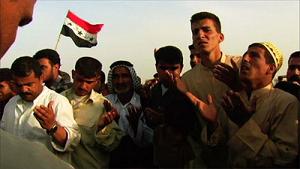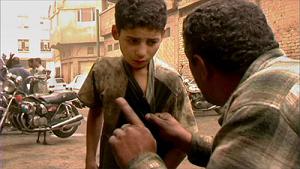

A few years ago, a small documentary entitled Voices of Iraq opened and closed with little fanfare. In it, the filmmakers gave ordinary Iraqis hand held video cameras, and allowed them to film their own lives. Now, Iraq in Fragments, one of the movies nominated for Best Documentary at the Oscars, arrives with a similar concept; allowing Iraqis to speak for themselves. There is a huge difference though - the tone is markedly different. Where Voices of Iraq was optimistic, James Longley's Iraq in Fragments is the opposite. Much of this has to do with the climate in which the film was made. With the passage of time, Iraqis are increasingly resentful at the presence of the United States in their country. They see the US as occupiers, foreigners after their oil. They are glad that Saddam Hussein is gone (well, for the most part), but they want to be able to make decisions for themselves, not have another country do so.
Longley opts for a different approach in his movie. He breaks the film into three sections (as well as using the obvious titular allusion), each one focusing on a different portion of Iraq. He visits Baghdad, the Shiite south where Moqtada Sadr holds power, and the northern Kurdish territories. Each segment is approximately half an hour, and the sheer length allows Longley to dive deeply into the lives of those that he interviews. He can take the time to examine their hopes, dreams, and frustrations. This is truest in the second segment in the south, primarily Naseriyah and Najaf. Here, Longley follows Sheik Aws al Kafaji through religious schools and discussions about governance. He captures locals as they try to debate the best way to create a government, and the best way to send a message to the US saying that they are ready for self governance.
The weakest segment is the first, which follows young Mohammed Haithem. Haithem dropped out of school to work in a small shop so that he could support his family. Longley wanted to show how the audience a view of Iraqi life is that sadly not too uncommon. Haithem lives in a poorer section of Iraq, where attitudes towards the US are deteriorating. People are bitter that they receive no humanitarian aid, while soldiers seem to be well fed. Looking at the world through the eyes of a child may give a different perspective on things, but ultimately Haithem doesn't have much to offer the viewer. The last segment in the Kurdish territory is similar. Longley chooses to focus on local farmers.
The movie works in the way that Longley presents his information. He spent long amounts of time with each of his subjects, gaining their trust and allowing him to work unimpeded. In this manner, his camera is no longer something to stare at, but merely something in the background. Longley captures the rhythms and movements of "ordinary" life in Iraq, and does so in a way that is visually engrossing, and the most interesting aspect of this movie.